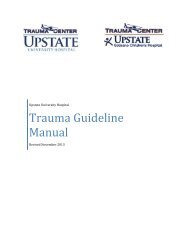2013-2014 Course Selection Book - SUNY Upstate Medical University
2013-2014 Course Selection Book - SUNY Upstate Medical University
2013-2014 Course Selection Book - SUNY Upstate Medical University
- No tags were found...
You also want an ePaper? Increase the reach of your titles
YUMPU automatically turns print PDFs into web optimized ePapers that Google loves.
Cell generation/proliferation, Cell migration andguidance, Cell death, Synaptogenesis, and Plasticity.TOPICS IN VISION I . . . . . . . . . . N6162 Credit HoursCoordinator(s):Dr. Eduardo SolessioPrerequisite(s): Introductory (e.g., undergraduate)neuroscience and N623 Systems Neuroscience isstrongly encouraged.Period Offered: Late Spring of odd numberedyears; By arrangement only<strong>Course</strong> Description: The course will examineneuroanatomical, electrophysiological, andpsychophysical aspects of vision. This is primarily areadings course, with emphasis on original literature.It is particularly appropriate for graduate studentsintending to conduct original research in the visualsystem. This first half will focus on visual mechanismsat the level of the retina, and will be offered on oddnumbered years.<strong>Course</strong> Format: The course will largely consist ofdiscussion sessions covering extensive readings oforiginal scientific literature. Grades will be based onclass participation.METHODS OF NEUROSCIENCERESEARCH2 Credit HoursCoordinator(s):Prerequisite(s):Period Offered:N617Dr. Barry Knoxand Neuroscience FacultyGS616 Foundations <strong>Course</strong>Spring 1-10 weeks(ends before N507 in Spring 2)<strong>Course</strong> Description: Survey of research methodsin NS. <strong>Course</strong> will include modules on the studyof gene expression, morphology of neurons andglia cells, neuronal and glial function, behavior,networks, inheritance, etc. Emphasis is onexperimental design, research protocols and datainterpretations. Most modules will include bothstudy of theory and actual hands-on practicethrough in-lab demonstrations of researchmethods.Textbook(s):NoneTOPICS IN VISION II2 Credit HoursN618Coordinator(s):Dr. Daniel Ts’o (Director)and Dr. Brad MotterPrerequisite(s): Introductory (e.g., undergraduate)neuroscience and N623 Systems Neuroscienceis strongly encouraged.Period Offered: Spring; By arrangement only<strong>Course</strong> Description: The course will examineneuroanatomical, electrophysiological, andpsychophysical aspects of vision. This is primarily areadings course, with emphasis on original literature.It is particularly appropriate for graduate studentsintending to conduct original research in thevisual system. This second half will focus on visualmechanisms beyond the level of the retina, focusingon the cortical contributions to visual processing andvisually-guided behavior.<strong>Course</strong> Format: The course will largely consist ofdiscussion sessions covering extensive readings oforiginal scientific literature. Grades will be based onclass participation.NEUROBIOLOGY OF DISEASE2 Credit HoursN619<strong>Course</strong> Director:Dr. Eric OlsonCoordinator(s):Basic Science andClinical Departments FacultyPrerequisite(s): GS616 Foundations of Molecular &Cellular Biology or permission of instructorPeriod Offered:Fall, odd yearsFirst half<strong>Course</strong> Description: Neurobiology of Disease willmeet twice per week, Mondays and Fridays, 2:00– 4:00 P.M. Each meeting will focus on one diseasewhere some of the molecular underpinnings areunderstood (e.g. Alzheimer’s Disease). The firsthour of class will be led by a research scientistor physician with expertise in the basic biologyof the disease. The class will discuss one reviewarticle and important research papers on themolecular mechanism of the disease. The secondhour of class will be conducted by a clinician andthe students will be introduced to the clinicaldimensions of the disease.Textbook(s):None24
















